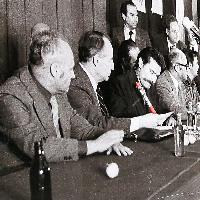Photographic collection of European Solidarity Centre documents the most important political events from the 1970s and 1980s in Northern Poland. They are a testimonial of suppression, fight and victory, but they also tell little histories: of alternative lifestyles and artistic sensibility. The still-growing archive resources contain over 63.000 items.
-
Vieta:
-
Temos:
-
Įkūrimo data:
-
Charakteringi eksponatai:
The private collection created and owned by Piotr ‘Pietia’ Wierzbicki contains hardcore punk fanzines, articles, and papers from the 1980s, including the original matrices of ‘QQRYQ’ fanzine edited and published by Wierzbicki from 1985. ‘QQRYQ’ was the leading Polish magazine about the underground punk scene and Wierzbicki became an influential author and promoter on that scene.
-
Vieta:
-
Temos:
-
Įkūrimo data:
-
Charakteringi eksponatai:
The Pitch-In Culture was a unique phenomenon of Polish cultural landscape of the 1980s. This informal community brought together radical, critical, and progressive artists from two different generations: the former members of the Zero-61 group and the Film Form Workshop, who had begun their activities back in the 1960s and their younger colleagues, who were breaking up with conceptualism and the ethos of the avant-garde. The nihilistic, anarchistic, neo-Dada circle of the Pitch-In Culture distanced itself both from the state-supported art and from the so-called “church” art created by artists related to the political opposition. The Pitch-In Culture Collection presents artists, their works, manifestos and texts, as well as the documentation of exhibitions and artistic performances.
-
Vieta:
-
Temos:
-
Įkūrimo data:
-
Charakteringi eksponatai:
Polish artists and circles involved in performance art were in many ways critical of Polish People's Republic authorities. They would often be involved in the so-called “second circuit” of publishers and galleries that functioned without public support and independently from national institutions. Performers’ actions themselves were also loaded critically not only towards the authoritarian practices of the “people’s” government, but also the patriarchal and hierarchical aspects of Polish culture.
The Archive of Museum of Modern Art in Warsaw presents the history of Polish performance art. It uses an attractive web portal to publish photographic and video recordings of artistic actions along with commentaries from curators. The Archive is also engaged in research and promotion activities, and is participating in the preparation of Museum’s permanent exhibition.
-
Vieta:
-
Warszawa Pańska 3, Poland
-
Temos:
-
Įkūrimo data:
-
Charakteringi eksponatai:
Punk in Polish People's Republic began in 1978 and it quickly gained popularity in Warsaw, as well as in other cities. In its initial phase, the movement maintained close ties with student clubs and galleries, where performance art, mail art, and concrete poetry flourished at the time. The collection of a punk photographer Anna Dąbrowska-Lyons includes zines, photographs, and newspaper clippings from the years 1978 to ca. 1982. The most interesting of these materials were featured in the album titled Polski punk (Polish Punk) published in 1999. The album documents the first wave of punk in Warsaw, while also presenting original, artistic photographs, collages, and graphics which blend the Western influence of punk and the new wave with the poetry of futurism, Dada, and conceptual theories of the 1970s.
-
Vieta:
-
London, United Kingdom
-
Warszawa, Warsaw, Poland
-
Temos:
-
Įkūrimo data:
-
Charakteringi eksponatai:




